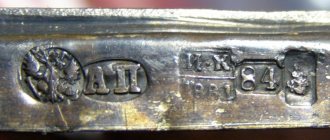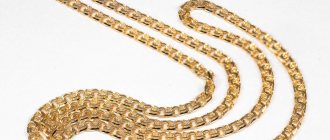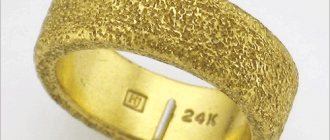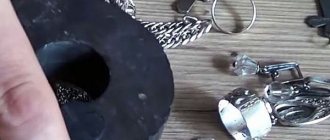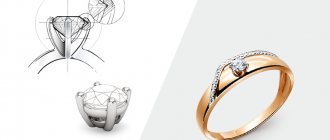Locks on chains made of precious metals should be as reliable as possible. Otherwise, they may unexpectedly open up one day, and the jewelry will unnoticeably slip off the neck and get lost. This is especially unpleasant when the chain is an exclusive product, a gift from a dear person, or is complemented by an amulet pendant or a pendant with a large expensive stone. There are different types of locks on gold chains. When choosing, you need to pay attention to their functionality and harmony with the decoration style. The lock must securely fix the product on the neck and not cause any discomfort to its owner. What types of chain clasps are there? Let's look at the most common types.
Spring clasp
This type of lock is more common than others and is a small ring that is used to complement delicate jewelry. This variety is equipped with a spring latch. The fittings are miniature in size and highly durable. Its disadvantages include the unreliability of the spring mechanism. If such a lock is attached to a gold chain, it must be constantly monitored and changed in a timely manner.
Gold chain with spring clasp
How to attach a clasp to a product?
With all the variety of fasteners, there are not so many ways to attach them to the product, or rather, devices that allow you to connect the product and the fastener. According to the type of fastening, fasteners are conventionally divided into:
- Self-sufficient - having a connecting element in the design: a detachable fastening loop, a callot, an end cap, etc.
- Requiring accessories/accessories : glue, connecting ring, pin, etc.
Depending on the type of product and the base used in its assembly, the same fastener can be attached in different ways and means.
Attaching a self-contained fastener
As mentioned above, self-sufficient fasteners are equipped with a detachable connecting loop or ring. The option seems to be the simplest. You don’t need anything except the fastener itself: take it and fasten it. But this simple option is also the most unpopular.
Firstly, everything that can be easily bent for connection is just as easily disconnected, at the most unexpected moment. Therefore, fastening a fastener with a cast (one-piece) connecting loop is considered more reliable. And, secondly, the fastener attached through auxiliary fittings ends up in the same plane with the product. But if you attach it directly with the existing detachable loop, the fastener will fit into a plane perpendicular to the product itself. This is necessary in exceptional cases, but in other cases it is inconvenient. The exception is detachable loops attached to the clasp via a rotating adapter, as in the photo above.
However, if you have a self-sufficient fastener in your hands, then you will only need a suitable tool to secure it to the product. It is enough to open the connecting loop with thin-nose pliers.
Next, all that remains is to thread the hook obtained from the loop into the loop or bow protruding from the decoration and tighten again.
Let us add that self-sufficient fasteners are also equipped with other fastening devices. Here is a regular carabiner clasp:
But its kit includes the entire range of fastening accessories: from connecting rings and an extension chain to an end clamp for tapes. And manufacturers also offer many such convenient options for completing a particular fastener system for a particular product.
Let's look at the most popular fastening devices for fasteners and methods of attaching them to the product.
Attaching a lock through a loop
In this case, the fastening loop for attaching the clasp is made from the same base that was used to assemble the jewelry. The fastener is attached to the resulting loop using a connecting ring, threading it sequentially through the formed loop at the end of the product and the fastening loop of the fastener itself. Or the detachable fastening loop of the fastener itself is threaded into the resulting loop.
To form a fastening loop at the end of the product, the base used in its assembly is simply tied in a knot so that a loop remains for further manipulation. Here is one of the easiest ways to tie such a knot.
This possibility of fastening is provided not only by threads, but also by cords:
Each needlewoman has her own knots and ways of tying them, but everyone has a common goal: to obtain a stable, strong knot that will reliably hold the loop formed from the base for attaching the fastener.
By the way, in bead weaving the same principle of a fastening loop from the base is often used, but more decorative. The loop is simply made from low beads. And if you approach the problem thoroughly, then from beads it is possible to make not only a loop for attaching a clasp, but also the clasp itself:
But this is a separate topic of conversation.
Here we will mention a modernized version of fastening through a loop, in which the loop serves only as an auxiliary tool. It attaches a connecting ring to the product, and the ring is used to further attach the fastener.
Fastening the lock through the protector
From a jewelry cable, the same fastening loop at the end of the product is formed using special auxiliary fittings. You have to resort to auxiliary fittings for two reasons. The lanka, firstly, cannot be tied in a knot, and secondly, it is vulnerable to breaking at the bend. Therefore, when forming a fastening loop at the end of the product, a special thread protection is used - a protector (it also serves as a fastening loop), and the fixation of the lanyard in such a loop is ensured by a crimp.
To create a loop, it is enough to sequentially thread the working thread into the clamping bead (aka crimp), then into the fastening holes of the tread, not forgetting to place the cable in the “horseshoe” groove. Then you should go through the clamping bead in the opposite direction and, having adjusted the desired tension, clamp the crimp. Then all that remains is to attach the clasp to the resulting loop.
Fastening the lock through a calotte
Kalotta (aka skufeika) is a type of camouflage clamp bead, equipped with a fastening loop. It is this loop that is used to attach the fastener to the product.
However, first you need to attach the calotte itself to the product.
To do this, the calotte is strung on a working thread. Its fixation is either a fastening knot, if the elasticity of the base allows you to tie one.
Another option is to attach the calotte to the outer bead of the product of a suitable size.
Or a crimp is used to secure it.
Let us add that in attaching a clasp to a product made of a rhinestone chain, the same function as the calotte is performed by the clamping connector-end.
Fastening the lock via a pin
To obtain a pin for attaching the fastener to the product, you will need either a pin or hard steel wire.
It is possible to use a pin nail (with a head) or a pin pin (with a ball), but then the upper part will have to be cut off and the fastening loop bent out yourself, using pliers. The most convenient way for this purpose is a pin with a ring. He already has one loop.
The pin itself is not enough; it works in tandem with a cap cap that masks connection flaws.
And at the heart of the connection is a pin that has two loops: the top one will attach the fastener, and the bottom one will attach the end cap to the edge of the product.
The same fastening pin, using the same tools, is bent from a small piece of steel wire.
Adhesive clasp fastening
Looking ahead, we will say that glue often acts only as an auxiliary tool that enhances the reliability of the connection. The same bead strand can be attached to the clasp in several ways. But if you choose a fastener option with a cylindrical end or a box end, where there is a hole for threading the base used in assembling the product, then a drop of glue in the end cup will not interfere with the main fastening, but will only make it stronger.
When assembling jewelry, there are often cases when craftsmen have to glue the clasp onto the product or glue the product into the clasp due to the lack of other connection options. This often happens with thread strands or leather cords.
As a clear example of variable fastening, let us cite fasteners that consist of two cylindrical ends connected to each other through a thread, a magnetic field, a mechanical latch, etc.
In essence, such a lock is a tube assembled from two parts. That is, the fastener has a longitudinal fastening hole into which it is enough to thread a thread, fishing line, strap and secure it with a bead of a suitable size with a stopper or crimp.
But the same “tubular” fasteners can be attached to a textile or leather cord. If the cord is elastic enough and passes through the fastening hole of the fastener, then it is also possible to tie a knot or attach another fastener. But if the diameter of the cord matches the diameter of the glass, or even slightly exceeds it (for the strength of the connection, this option is quite good), then you will have to be content with an adhesive fastening and only that.
To do this, just coat the inner walls of the end cup with glue, insert the end of the cord into it and let the glue dry.
If the ends of the cord are frayed or its diameter slightly exceeds the internal volume of the end cap, you cannot do without an additional adhesive procedure. First, the cord itself is treated with glue at the point of connection. After drying (completely or partially depending on the properties of the glue and the cord itself), the glued ends of the cord, that is, those that have become more obedient, are easier to bring into line with the diameter of the fastener: compress, sharpen, trim to a convenient shape. The ends of the decoration corrected in this simple way are easier to insert into the end piece greased from the inside with glue.
Actually, the same principle remains the same when working with all fasteners that leave the possibility of adhesive attachment. Leave everything that has an internal niche, cavity, recess for placing and securing tape, braid, cord, rope, etc. Different methods of fastening are possible, but an auxiliary drop of glue is always ready to provide insurance.
To summarize what has been said, we note that the well-known gluing rules also apply to adhesive fastening of fasteners:
- Choose an adhesive that is suitable for working with the materials you have.
- Before applying the adhesive layer, thoroughly degrease smooth, non-absorbent surfaces, and do not be lazy to apply an additional layer of glue on absorbent ones.
- After gluing, the product is left completely alone until completely dry.
Carbine
This is a hinge with a moving bracket, suitable for large items. The locks are easy to use, durable, and can be repaired. They rarely unfasten on their own, but require careful handling. It is necessary to unfasten and fasten the carabiners carefully, without sudden jerks. Otherwise, the loop will be deformed and the lock will fail.
Gold chain with lobster clasp
Useful tips for choosing fasteners
During the operation of the product, the main load is placed on its fastener. Moreover, the task becomes more complicated if you want to add a pendant or pendant. Over time, the mechanism may weaken or fail completely.
There are a number of requirements for the quality of the lock:
- all parts of the mechanism must ensure smooth closing, without jerking or shifting;
- must fit perfectly with the main product and match the metal from which the chain is made;
- the fastener itself must be perfectly smooth and not chipped or jagged;
- the most convenient ones are those that you can open with one hand;
- An important aspect is where you will put the chains on. If your job involves physical activity, then you should leave your jewelry at home.
All locks must meet these requirements. When choosing the perfect piece of jewelry (no matter what kind of chain it is gold or silver), you must take into account all the rules. Then your product will be not only an object of beauty, but also of reliability. After all, such insignificant parts as a clasp can turn out to be the most important elements.
Stylish grandma is an Instagram star, who is she?
Pattern of a floor-length dress
Butterfly
One of the most reliable locks. On chains, the butterfly is less common than other types of fasteners. The fittings prevent arbitrary unfastening and prevent accidental loss of jewelry. The clasp has a butterfly shape and is quite large in size, but is almost invisible on the products.
On the left is a figure eight lock, on the right is a butterfly lock.
Hook closure
A hook is the simplest of closing devices. A hook fastener always has a bend, at least at one end, suitable for hooking something. In the case of a clasp for jewelry, the hook engages a loop that is appropriate in size and this is sufficient to close the jewelry into a circle and hold it. Most often, a clasp with a hook also comes with a loop, but this is not necessary.
Please note that the hook clasp is available in several versions:
- Regular hook - there is one hooking bend of some shape;
- S - shaped hook - has two bends on both sides and both are capable of hooking and holding: for a double-sided hook, two loops are respectively required. Such a fastener, by and large, does not require permanent fastening. It can serve several decorations in turn.
- Two-component - in addition to the hook itself, the kit also includes a loop for it.
- One-component - a loop is not included in the kit, there is only a hook and the manufacturer offers to decide for yourself which holding element to hook it to.
The smoothness and angle of bending, sizes, and decor of hook fasteners are varied. When choosing, you should pay attention to the quality of the alloy. Excessive fragility can cause the hook to break, and excessive malleability can lead to its extension. The hook has no additional insurance, which is why it is the simplest. So don’t be shy, before buying a hook fastener, be sure to touch, feel, examine, try to hook and pull.
And further. The hook is designed for heavy jewelry. Under the weight of the product, the hook does its job properly. Fastening, at the same time, with one precise, light movement.
Among the advantages of the hook:
- Simplicity - remember, the simpler the design, the less likely it is to break;
- Easy to fasten;
- Large selection of styles and decor;
- Can be used with an extension chain;
The disadvantages include:
- Low reliability: unfastens as easily as fastens;
- It is absolutely not suitable for elegant light jewelry: firstly, the hook is a rather large clasp, and secondly, as mentioned above, on its own, without the counteracting force of gravity of the jewelry, it does not work;
Chain lock
The fittings are used in thin chains and look elegant and graceful. It has a simple design consisting of a small tube and a barbed hook. The lock is easy to fasten, but jewelry with it must be removed at night. The clasp may get caught on a pillow or blanket and break.
Left: chain lock, right: screw lock
High-quality chains and bracelets at Diamant.ua!
YUK men's bracelets/chains are distinguished by their elegant design and cutting craftsmanship. Our assortment includes a large selection of products for women and men with stone inserts on a carabiner lock and a buckle. These are models with flowers and geometric symbols, with multi-colored and plain inlays.
Want something original? Customize your accessory parameters - from cut to insert shape/color!
No decorations
Are you looking for a delicate wedding option with pearls and zirconium, or a bracelet with curly rings for every day? Choose what is closest to you. We provide safe delivery and quality guarantee!
Box
A very reliable and durable clasp designed for large silver and gold chains. It consists of a barbed hook that fits into a small box. The locks come in various sizes and can be equipped with double-sided locks. This is the best option for clasps for very expensive jewelry, preventing their accidental loss.
Silver chain with box lock
Learning to understand fasteners: main selection criteria
It is the clasp that bears the greatest functional load when wearing gold chains/bracelets. By complementing the product with pendants and pendants, we make them even heavier. If the mechanism is strong, then the lock is not in danger of losing its shape, but if not, it can easily become deformed, or even burst.
To prevent this from happening, the lock must be:
- Tight, and its parts are flexible (move/bend smoothly without jamming);
- Smooth, without sharp corners/jags;
- Easy to open.
Hinge locks - originality and aesthetics
These mounts are based on a movable connection between two elements, which allows them to rotate freely around their axis.
A pin is inserted into the loops of the fastener - a kind of “nail” made of durable metal, which secures the entire device. Hinge locks look best on solid (rigid) bracelets. Sometimes they are also supplied with glider decorations consisting of individual links.
Buckle lock - convenient, but unreliable
This mechanism also works on hinges, but without a pin.
It is replaced by a latch, which folds in half and is then fixed using a special strip with holes. These locks can be seen on metal watch bracelets, as well as on casual jewelry that combines metal, leather and rubber. Fastening the buckle is very easy. But, unfortunately, it also opens almost effortlessly. This means that you may well lose your jewelry simply by touching an object with your wrist or by accidentally pulling on the bracelet.
We put on the bracelet using a thick thread
Strong yarn is suitable for this method. The thread does not need to be cut from the skein. Its end is threaded into the link of the decoration and folded into a loop, which is fixed with the fingers on the palm. The bracelet is placed on the wrist and fastened with the free hand. This technique is suitable for jewelry with large links. If they are small, the thread will be difficult to thread. Then, in order to fasten the bracelet on your hand yourself, you need to use another method.
View the entire GOLDEN GLOW collection in the SUNLIGHT catalog
Box-shaped
Craftsmen like to use such a fastener for products where, according to the plan, the fastener should not stand out from the overall composition
Box locks look like two elements: a clasp is inserted into a square piece, which has small protrusions at the tip.
The box mechanism is not often used in the jewelry industry. The fact is that the process of making the retainer is quite labor-intensive . But, despite this, the lock always looks beautiful on the accessory , as it fully corresponds to the intended design.

